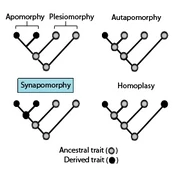
Synapomorphies (Page & Holmes, 1998)

Chordates - CrashCourse Biology 24
Synapomorphies in Chordata
In a cladistic phylogenetic tree a synapomorphy is a shared characteristic between multiple taxa with a common ancestor. The shared trait, or characteristic, is assumed to also have occured in the most recent common ancestor and is evidence of their relation (in addition to other data such as DNA sequencing, etc.). There are many ways in which researchers analyze morphological data to determine the significance of related traits (Wheeler, 2003). Ultimately, though, it is difficult to always utilize synapomorphies as identifiable cues for taxonomic records because fossils are often incomplete and may not allow for examination of key parts, particularly those that decay quickly (Sansom, Gabbott, & Purnell, 2010).
Synapomorphies in Chordata[]
Chordata includes over 75,000 animals, including humans. All of these animals share the following five characteristics, or synapomorphies (Hank, 2012; Chordata, 2013):
- a Notochord
- a Dorsal Nerve Chord
- Phyrengeal Slits
- an Endostyle
- a Post-anal Tail
Although these traits take many different forms within the widely varying species of the phylum Chordata they are all present within us, from hagfish to humans. These synapomorphies are thought to have evolved some 500 million years ago (Hank, 2012).
Related terminology[]
Symplesiomorphy: Similar to synapomorphy this refers to a shared trait among multiple taxa but the difference is that rather than being unique to a recent common ancestor these traits are spread amongst taxa that share a more distant ancestor. Therefore, it does not imply as close of a linkage and isn't necessarily as helpful in taxonomic classification; it's a weaker association (Synapomorphy, 2013).
Homoplasy: This is essentially a shared characteristic between multiple taxa where the trait evolved independently within each group. This implication is only found by examining the phylogenetic relationships and determining that the ancestor of the taxa did not also share this characteristic.
Because such confounding terms exist, it's clear that just because a trait is found between multiple taxa you cannot automatically assume that their common ancestor also had this trait, nor that they are closely related. Instead, a combination of research needs to lead to the conclusion that a trait is, in fact, a synapomorphy and that the taxa are sisters.
Sources[]
Chordata (2013). Retrieved from: http://en.wikipedia.org/wiki/Chordate
Hank (2012). Chordates: Crash Course Biology #24. Retrieved from: http://www.youtube.com/watch?v=kgZRZmEc9j4
Page, R. and Holmes, E. (1998). Molecular evolution: a phylogenetic approach. Wiley-Blackwell, 1st edition.
Sansom, R. S., Gabbott, S. E., & Purnell, M. A. (2010). Non-random decay of chordate characters causes bias in fossil interpretation. Nature, 463(7282), 797-800.
Synapomorphy (2013). Retrieved from: http://en.wikipedia.org/wiki/Synapomorphy#cite_note-1
Wheeler, W. C. (2003). Implied alignment: a synapomorphy‐based multiple‐sequence alignment method and its use in cladogram search. Cladistics, 19(3), 261-268.